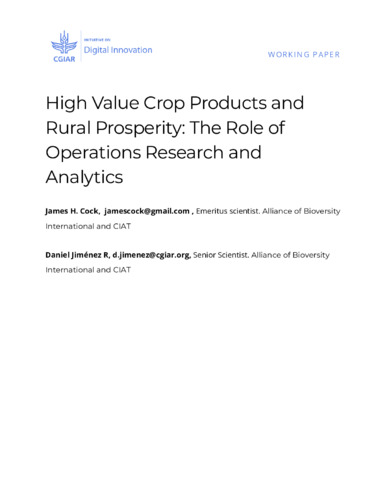High value crop products and rural prosperity: The role of operations research and analytics
This working paper examines the pivotal role of High Value Crop Products (HVCPs) in modern agricultural research and development, emphasizing their potential to significantly enhance rural prosperity and address global challenges such as poverty and food security. The paper argues for a shift in agricultural focus from traditional staple crops to HVCPs, highlighting their ability to generate higher income per unit of land and labor, thereby offering an effective solution to rural poverty. Traditional agricultural research and technology development methodologies must be amortized over a large production base to be cost effective due to their high cost. However, to maintain their status as HVCPs the products must be differentiated, which precludes having a large production base. Currently, most HVCP producers carry out their own research and development which is commonly by traditional trial and error. A further limitation of traditional agricultural research methodology is the time required to obtain results, especially with perennial crops. Moreover, the complexity of agriculture with multiple interactions between factors makes it nigh on impossible to obtain information on all the variables that might be important. Operations Research, which looks at an organization’s operations and uses mathematical or computer models, or other analytical approaches, to find better ways of doing things, overcomes many of the limitations of the traditional research methods. Of special significance are the speed with which useful information is generated due to the ability to use current and historical data from existing crops, rather than planting them and waiting several years for the results; the study of multiple factors and their interactions; and the emulation of real conditions which sidesteps the need to later validate the technology under commercial conditions. Thus, the integration of operations research and advanced analytics, including data acquisition, machine learning, and artificial intelligence, in optimizing the cultivation and marketing of HVCPs. These methodologies provide deeper insights and facilitate more informed and strategic decision-making processes in agriculture. The paper also acknowledges the challenges associated with HVCPs, such as the necessity for product differentiation and the risks involved in new crop introductions, while underscoring the broader opportunities they present for employment, economic diversification, and sustainable development, especially in land-scarce regions. Concluding with future perspectives, the paper recommends a holistic approach that involves both public and private sector participation, advocating for a data-driven, analytical approach in agricultural strategies. This study underscores the need for OR in HVCP development, providing systematic approaches to data acquisition, business management, product identification, and effective management practices across the value chain.

